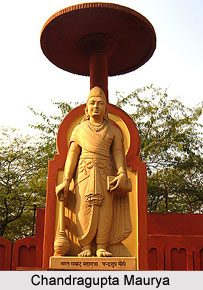 Chandragupta Maurya was the founder of the Mauryan Empire. He succeeded in conquering most of the Indian subcontinent. With his accession to the throne Jainism assumed a new phase in the Indian history. According to the Jain texts he is believed to have been born in a high family of kshatriya caste. Chandragupta Maurya had a firm inclination towards Jainism. A Jain tradition related in the Tiloyapannatt and Rajavalikatha claims him to be a Jain. According to a Jain text Lord Mahavira preached among the Mauryas. One of the chief apostles of Mahavira was a Moriyaputta and there were also many other Moriyaputtas who became his disciples. Chandragupta has always been styled as a Jain king. Apart from Indians, many Greek historians have mentioned about the existence of Jain monks within the empire of Chandragupta. Megasthanese, the Greek emissary to Chandragupta`s court, mentions of Sarmanas (Sramanas) in his empire. He also says that Chandragupta submitted to the devotional teaching of the Sramanas.
Chandragupta Maurya was the founder of the Mauryan Empire. He succeeded in conquering most of the Indian subcontinent. With his accession to the throne Jainism assumed a new phase in the Indian history. According to the Jain texts he is believed to have been born in a high family of kshatriya caste. Chandragupta Maurya had a firm inclination towards Jainism. A Jain tradition related in the Tiloyapannatt and Rajavalikatha claims him to be a Jain. According to a Jain text Lord Mahavira preached among the Mauryas. One of the chief apostles of Mahavira was a Moriyaputta and there were also many other Moriyaputtas who became his disciples. Chandragupta has always been styled as a Jain king. Apart from Indians, many Greek historians have mentioned about the existence of Jain monks within the empire of Chandragupta. Megasthanese, the Greek emissary to Chandragupta`s court, mentions of Sarmanas (Sramanas) in his empire. He also says that Chandragupta submitted to the devotional teaching of the Sramanas.
The Jain religion undoubtedly gained much importance in Magadha during the time of the later Saisunagas, the Nandas and the Mauryas. Jainas habitually employ Brahmanas for their domestic ceremonies but in Mudra- Rakshasa, a Jain ascetic has been mentioned as being a special friend of the minister Rakshasa, who served first the Nanda and then the new sovereign.
Renunciation of Chandragupta Maurya
The important occasion of Chandragupta Maurya`s reign was the forecast of a twelve years famine. At that time Acharya Bhadrabahu was the head of the Jain church. According to the Jain text Rajvaliya Katha, the king saw sixteen dreams. He requested Bhadrabahu to interpret the dreams. The latter explained all the dreams and according to the last one, he predicted a famine of twelve years.
The copper plate inscription of Sohagaura in the Gorakhpur district and Mahasthana inscriptions in the Bogra District provide evidences of this famine. It also describes about the precautions taken by the affected persons. The inscriptions have been written in Brahmi script during the time of Chandragupta Maurya.
Fearing the consequences and complexities of the prophecy of Bhadrabahu, a large number of Jains moved towards the South. This also included Bhadrabahu. Chandragupta, who was a follower of Bhadrabahu, gave up his throne. He crowned his son Simhasena and went to South. Both the teacher and pupil lived at a foot hill for some years after which Bhadrabahu died in the orthodox Jain way Sallekhana. He had completely rejected food. Chandragupta being the main disciple performed his funeral rites. After this event, Simhasena`s son Bhaskar came to South India. He respected Chandragupta and had erected a town named Belgola.
Literary evidence regarding Shravanabelagola
Chandragupta Maurya lived at Shravanabelagola for several years in a cave. There he spent his time worshipping the foot-prints of his teacher Bhadrabahu. He finally ended his life following the Jain fashion. According to the Tibetan account Kautilya saw the abdication of Chandragupta Maurya.




















